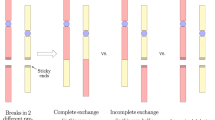Abstract
We investigated the DNA damage from Auger electrons emitted from incorporated stable iodine (127I), following photoelectric absorption of external x-rays. The effectiveness of the Auger electrons in producing DNA double-strand breaks (DSB) was determined theoretically, using Monte Carlo simulations of the radiation physics and chemistry, and was shown to be in reasonable agreement with DNA damage measured using the comet assay. The DSB yields were measured in CHO cells for 60Co (as a non-Auger-promoting radiation) and for tungsten-filtered 100 kVp x-rays capable of producing Auger electron emission. The theoretical study showed that on average, 2.5 Auger electrons were emitted for N-shell orbital vacancies and up to 10 Auger electrons were emitted from L1-shell vacancies. These Auger bursts produced approximately 0.03 DSB per N-shell vacancy and 0.3 DSB per K-shell or L-shell vacancy. The calculated yield of DSB from Auger cascades per unit dose (1 Gy) in water was approximately 1.7 for tungsten-filtered 100 kVp x-rays, assuming 20% IUdR substitution of thymidine. The comet assay yielded an experimental value of 3.6±1.6 per 1 Gy for the same conditions. The Monte Carlo simulations also demonstrated a high complexity of DSB produced by Auger cascades with virtually all DSB from inner shell orbitals (i.e. K, L shells) accompanied by compounded strand breakage and base damage, indicating a difficult lesion to repair. This finding agrees well with comet assay results of DNA repair, where an increase in the DSB yield in IUdR-sensitized cells was shown to persist after a time of 24 h. We conclude that Auger cascades in iodine produce a modest increase in the number of initial strand breaks of the order of 10% but the complex nature of these DSB makes them very difficult to repair or potentially prone to misrepair. The accentuated DNA damage may have major consequences for cell survival and may be exploitable in kilovoltage photon activation therapy (PAT) of tumors sensitized with iodine.
Similar content being viewed by others
Author information
Authors and Affiliations
Additional information
Received: 23 October 2000 / Accepted: 26 March 2001
Rights and permissions
About this article
Cite this article
Karnas, S., Moiseenko, V., Yu, E. et al. Monte Carlo simulations and measurement of DNA damage from x-ray-triggered Auger cascades in iododeoxyuridine (IUdR). Radiat Environ Biophys 40, 199–206 (2001). https://doi.org/10.1007/s004110100099
Issue Date:
DOI: https://doi.org/10.1007/s004110100099




